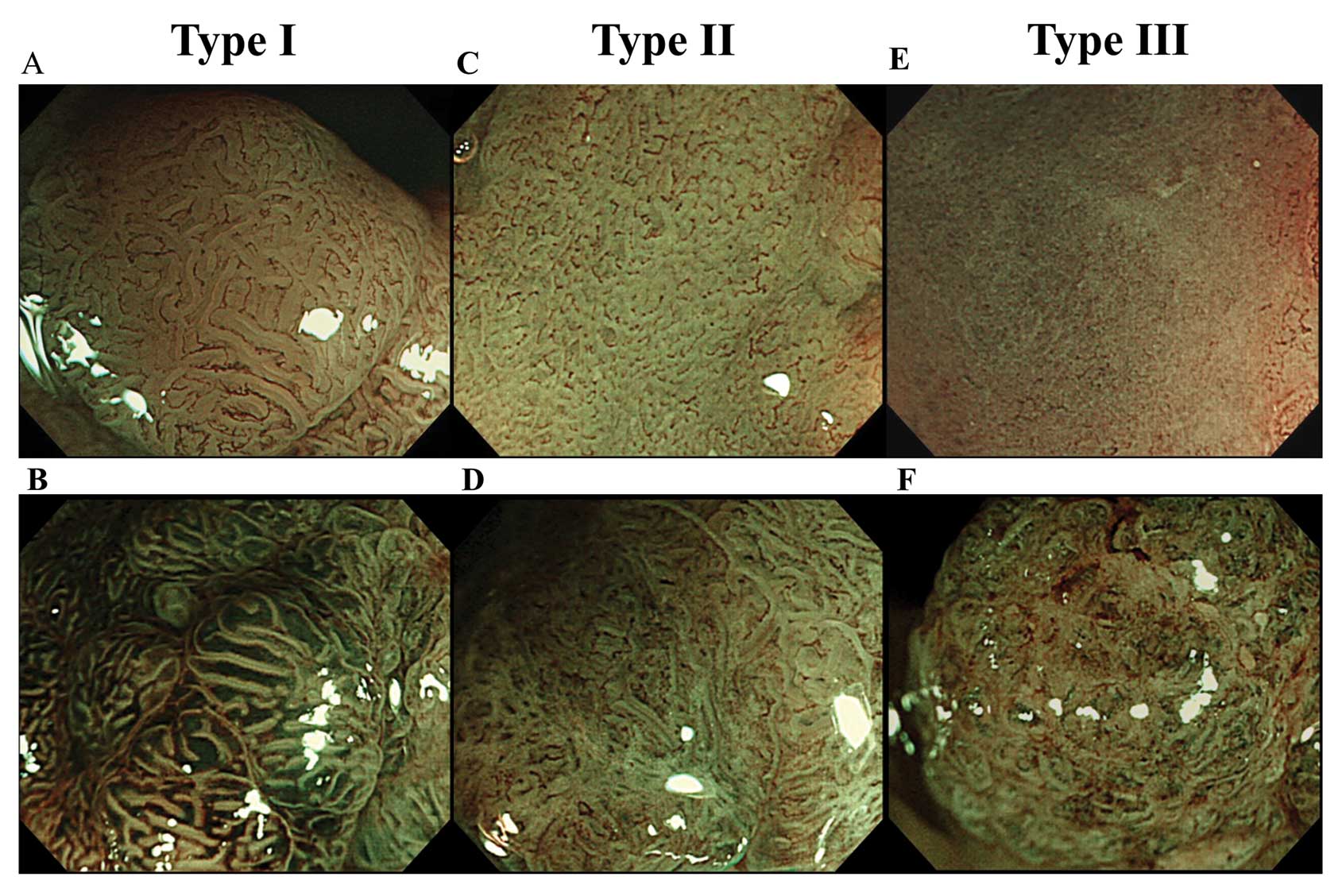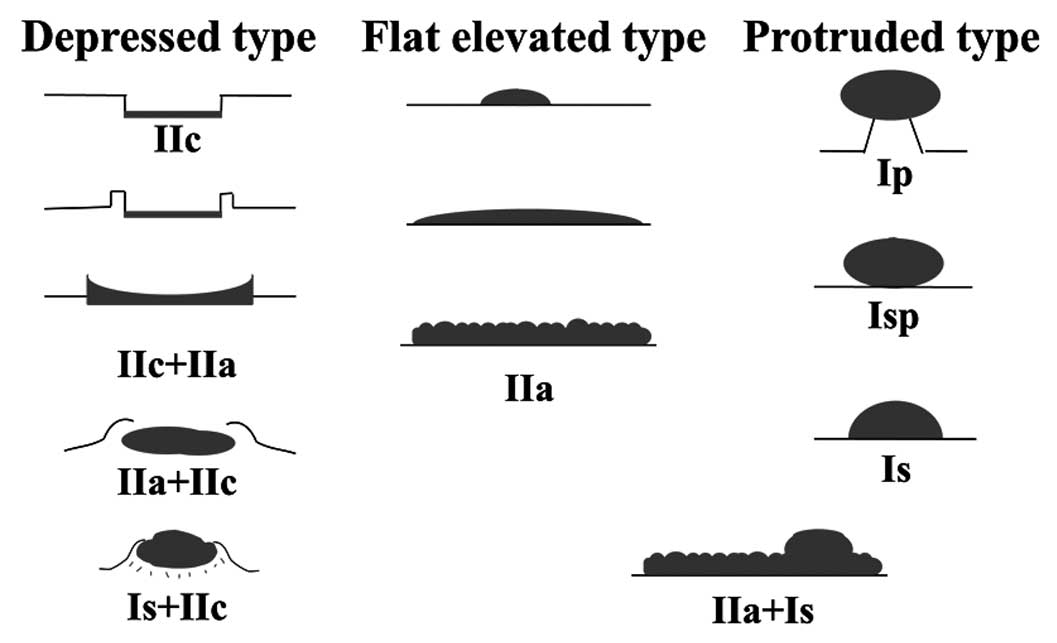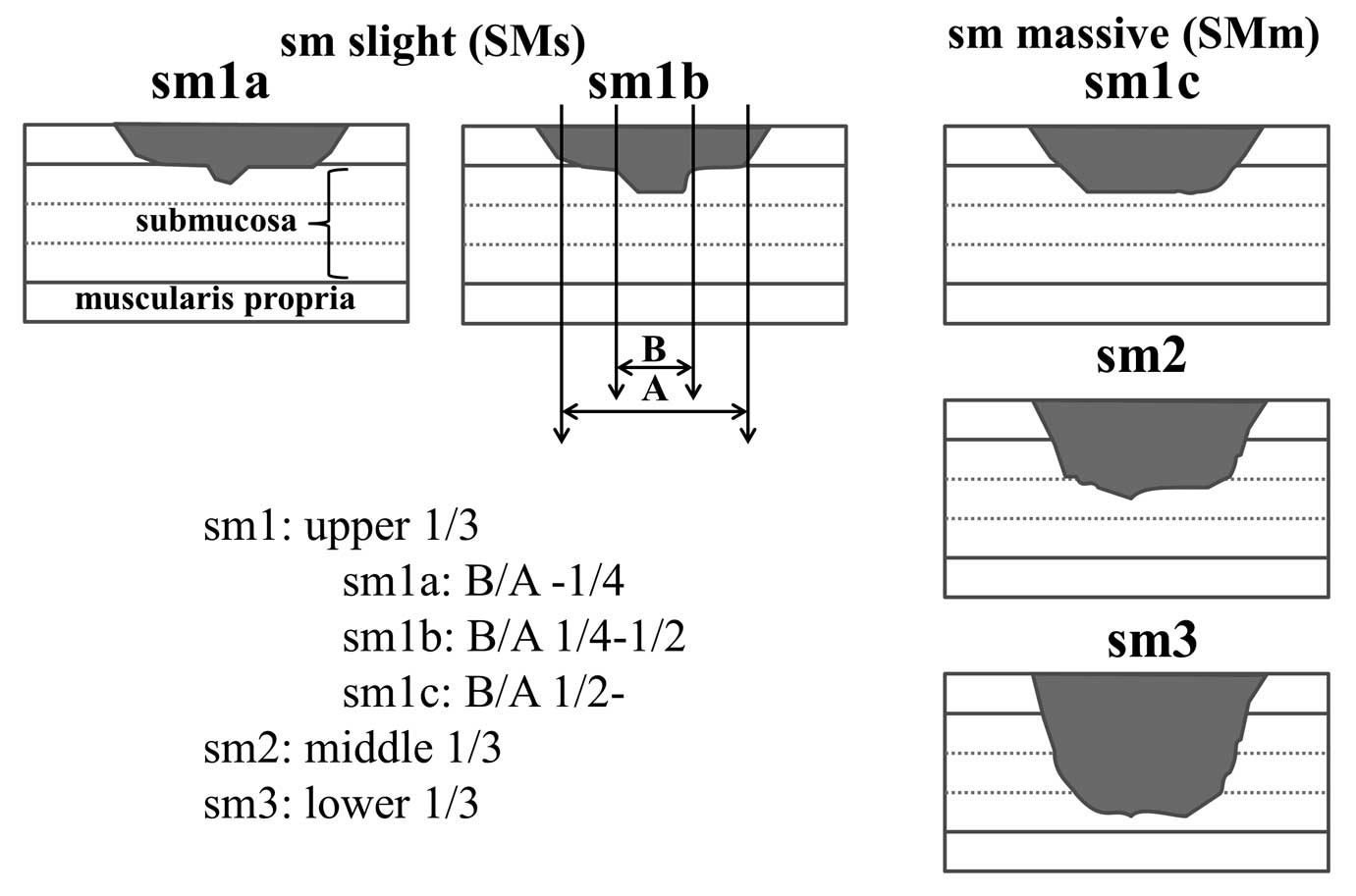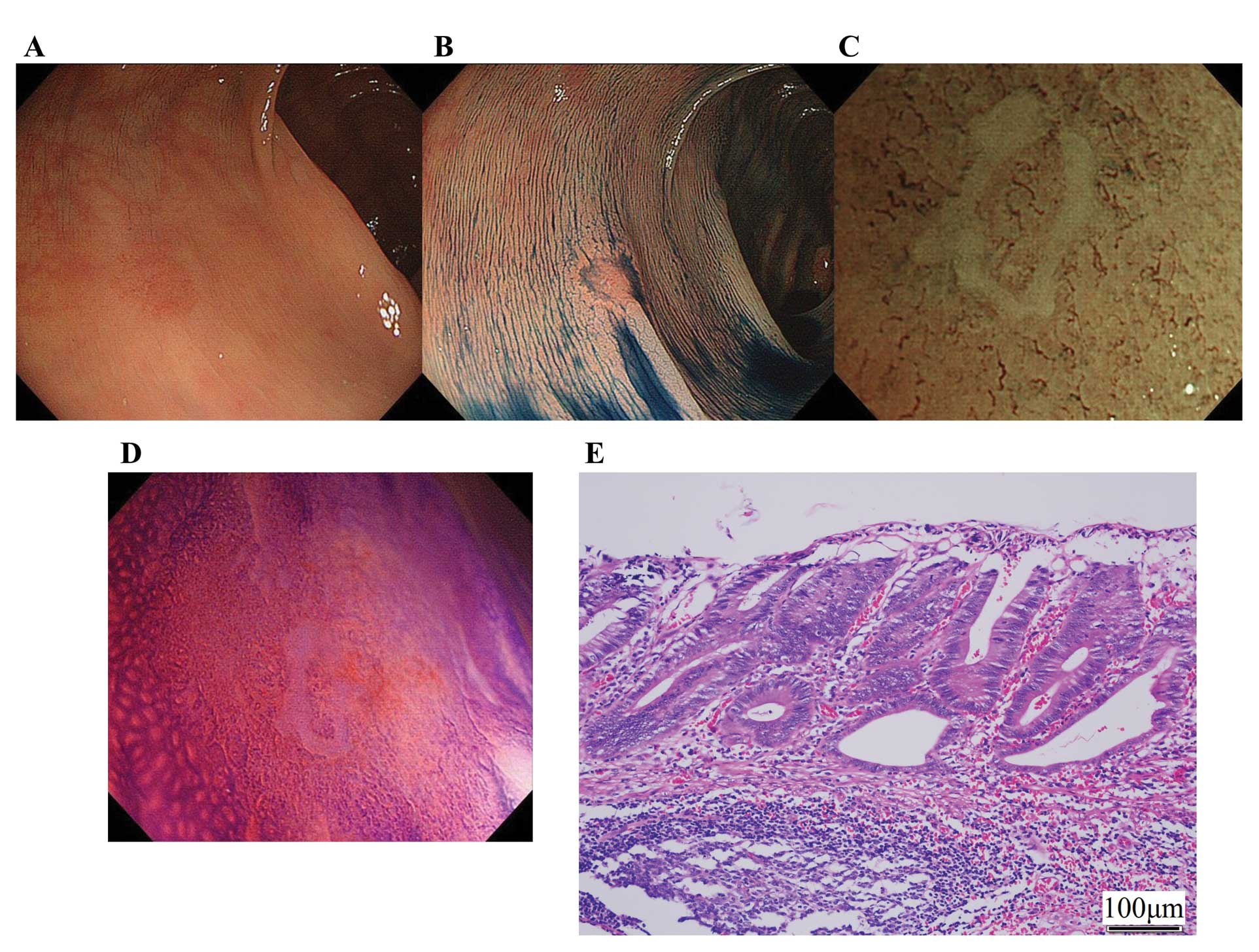|
1
|
Sano Y, Muto M and Tajiri H:
Optical/digital chromoendoscopy during colonoscopy using
narrow-band imaging system. Digest Endosc. 17:S43–S48. 2005.
View Article : Google Scholar
|
|
2
|
Machida H, Sano Y, Hamamoto Y, et al:
Narrow-band imaging in the diagnosis of colorectal mucosal lesions:
a pilot study. Endoscopy. 36:1094–1098. 2004. View Article : Google Scholar : PubMed/NCBI
|
|
3
|
Tischendorf JJ, Wasmuth HE, Koch A, Hecker
H, Trautwein C and Winograd R: Value of magnifying chromoendoscopy
and narrow band imaging (NBI) in classifying colorectal polyps: a
prospective controlled study. Endoscopy. 39:1092–1096. 2007.
View Article : Google Scholar : PubMed/NCBI
|
|
4
|
East JE, Suzuki N, Bassett P, et al:
Narrow band imaging with magnification for the characterization of
small and diminutive colonic polyps: pit pattern and vascular
pattern intensity. Endoscopy. 40:811–817. 2008. View Article : Google Scholar : PubMed/NCBI
|
|
5
|
Katagiri A, Fu KI, Sano Y, et al: Narrow
band imaging with magnifying colonoscopy as diagnostic tool for
predicting histology of early colorectal neoplasia. Aliment
Pharmacol Ther. 27:1269–1274. 2008. View Article : Google Scholar : PubMed/NCBI
|
|
6
|
Sano Y, Ikematsu H, Fu KI, et al: Meshed
capillary vessels by use of narrow-band imaging for differential
diagnosis of small colorectal polyps. Gastrointest Endosc.
69:278–283. 2009. View Article : Google Scholar : PubMed/NCBI
|
|
7
|
Henry ZH, Yeaton P, Shami VM, et al:
Meshed capillary vessels found on narrow-band imaging without
optical magnification effectively identifies colorectal neoplasia:
a North American validation of the Japanese experience.
Gastrointest Endosc. 72:118–126. 2010. View Article : Google Scholar
|
|
8
|
Fukuzawa M, Saito Y, Matsuda T, Uraoka T,
Itoi T and Moriyasu F: Effectiveness of narrow-band imaging
magnification for invasion depth in early colorectal cancer. World
J Gastroenterol. 16:1727–1734. 2010. View Article : Google Scholar : PubMed/NCBI
|
|
9
|
Wada Y, Kudo SE, Kashida H, et al:
Diagnosis of colorectal lesions with the magnifying narrow-band
imaging system. Gastrointest Endosc. 70:522–531. 2009. View Article : Google Scholar : PubMed/NCBI
|
|
10
|
Wada Y, Kashida H, Kudo SE, Misawa M,
Ikehara N and Hamatani S: Diagnostic accuracy of pit pattern and
vascular pattern analyses in colorectal lesions. Dig Endosc.
22:192–199. 2010. View Article : Google Scholar : PubMed/NCBI
|
|
11
|
Wada Y, Kudo SE, Misawa M, Ikehara N and
Hamatani S: Vascular pattern classification of colorectal lesions
with narrow band imaging magnifying endoscopy. Dig Endosc. 23(Suppl
1): 106–111. 2011. View Article : Google Scholar : PubMed/NCBI
|
|
12
|
Kudo SE, Tamura S, Nakajima T, Yamano H,
Kusaka H and Watanabe H: Diagnosis of colorectal tumorous lesions
by magnifying endoscopy. Gastrointest Endosc. 44:8–14. 1996.
View Article : Google Scholar : PubMed/NCBI
|
|
13
|
Kudo SE, Rubio CA, Teixeira CR, Kashida H
and Kogure E: Pit pattern in colorectal neoplasia: endoscopic
magnifying view. Endoscopy. 33:367–373. 2001. View Article : Google Scholar : PubMed/NCBI
|
|
14
|
Kashida H and Kudo SE: Early colorectal
cancer: concept, diagnosis, and management. Int J Clin Oncol.
11:1–8. 2006. View Article : Google Scholar
|
|
15
|
Kanao H, Tanaka S, Oka S, Hirata M,
Yoshida S and Chayama K: Narrow-band imaging magnification predicts
the histology and invasion depth of colorectal tumors. Gastrointest
Endosc. 69:631–636. 2009. View Article : Google Scholar : PubMed/NCBI
|
|
16
|
Oba S, Tanaka S, Oka S, et al:
Characterization of colorectal tumors using narrow-band imaging
magnification: combined diagnosis with both pit pattern and
microvessel features. Scand J Gastroenterol. 45:1084–1092. 2010.
View Article : Google Scholar : PubMed/NCBI
|
|
17
|
Oka S, Tanaka S, Takata S, Kanao H and
Chayama K: Clinical usefulness of narrow band imaging magnifying
classification for colorectal tumors based on both surface pattern
and microvessel features. Dig Endosc. 23(Suppl 1): 101–105. 2011.
View Article : Google Scholar : PubMed/NCBI
|
|
18
|
Oba S, Tanaka S, Sano Y, Oka S and Chayama
K: Current status of narrow-band imaging magnifying colonoscopy for
colorectal neoplasia in Japan. Digestion. 83:167–172. 2011.
View Article : Google Scholar : PubMed/NCBI
|
|
19
|
Tanaka S and Sano Y: Aim to unify the
narrow band imaging (NBI) magnifying classification for colorectal
tumors: current status in Japan from a summary of the consensus
symposium in the 79th Annual Meeting of the Japan
Gastroenterological Endoscopy Society. Dig Endosc. 23(Suppl 1):
131–139. 2011. View Article : Google Scholar
|
|
20
|
Hayashi N, Tanaka S, Kanao H, Oka S,
Yoshida S and Chayama K: Relationship between narrow-band imaging
magnifying observation and pit pattern diagnosis in colorectal
tumors. Digestion. 87:53–58. 2013. View Article : Google Scholar : PubMed/NCBI
|
|
21
|
East JE, Suzuki N and Saunders BP:
Comparison of magnified pit pattern interpretation with narrow band
imaging versus chromoendoscopy for diminutive colonic polyps: a
pilot study. Gastrointest Endosc. 66:310–316. 2007. View Article : Google Scholar : PubMed/NCBI
|
|
22
|
Hirata M, Tanaka S, Oka S, et al:
Magnifying endoscopy with narrow band imaging for diagnosis of
colorectal tumors. Gastrointest Endosc. 65:988–995. 2007.
View Article : Google Scholar : PubMed/NCBI
|
|
23
|
Kudo SE, Kashida H, Nakajima T, Tamura S
and Nakajo K: Endoscopic diagnosis and treatment of early
colorectal cancer. World J Surg. 21:694–701. 1997. View Article : Google Scholar
|
|
24
|
Kudo SE, Kashida H, Tamura T, et al:
Colonoscopic diagnosis and management of nonpolypoid early
colorectal cancer. World J Surg. 24:1081–1090. 2000. View Article : Google Scholar : PubMed/NCBI
|
|
25
|
Dixon MF: Gastrointestinal epithelial
neoplasia: Vienna revisited. Gut. 51:130–131. 2002. View Article : Google Scholar : PubMed/NCBI
|
|
26
|
Tanaka S, Oka S, Hirata M, et al: Pit
pattern diagnosis for colorectal neoplasia using narrow band
imaging magnification. Digest Endosc. 18:S52–S56. 2006. View Article : Google Scholar
|
|
27
|
Rastogi A, Pondugula K, Bansal A, et al:
Recognition of surface mucosal and vascular patterns of colon
polyps by using narrow-band imaging: interobserver and
intraobserver agreement and prediction of polyp histology.
Gastrointest Endosc. 69:716–722. 2009. View Article : Google Scholar
|
|
28
|
Japanese Society for Cancer of the Colon
and Rectum. Japanese Classification of Colorectal Carcinoma. 2nd
edition. Kanehara & Co., Ltd; Tokyo: pp. 112009
|
|
29
|
Kudo SE, Lambert R, Allen JI, et al:
Nonpolypoid neoplastic lesions of the colorectal mucosa.
Gastrointest Endosc. 68:S3–47. 2008. View Article : Google Scholar : PubMed/NCBI
|
|
30
|
Kudo SE: Endoscopic mucosal resection of
flat and depressed types of early colorectal cancer. Endoscopy.
25:455–461. 1993. View Article : Google Scholar : PubMed/NCBI
|
|
31
|
Kudo SE, Tamure S, Nakajima T, et al:
Depressed type of colorectal cancer. Endoscopy. 27:54–61. 1995.
View Article : Google Scholar
|
|
32
|
Kudo SE, Tamegai Y, Yamano H, Imai Y,
Kogure E and Kashida H: Endoscopic mucosal resection of the colon:
the Japanese technique. Gastrointest Endosc Clin N Am. 11:519–535.
2001.PubMed/NCBI
|
|
33
|
Ikematsu H, Matsuda T, Emura F, et al:
Efficacy of capillary pattern type IIIA/IIIB by magnifying narrow
band imaging for estimating depth of invasion of early colorectal
neoplasms. BMC Gastroenterol. 10:332011. View Article : Google Scholar : PubMed/NCBI
|













